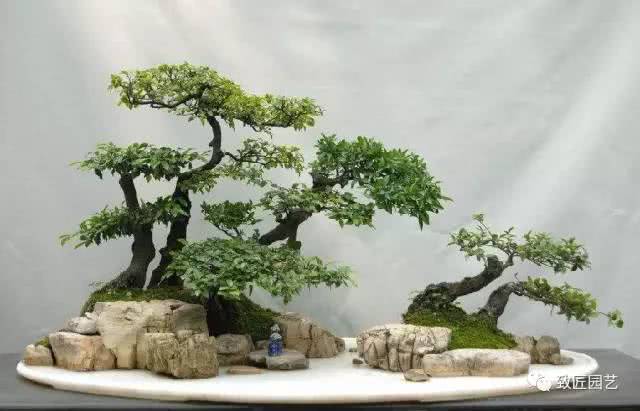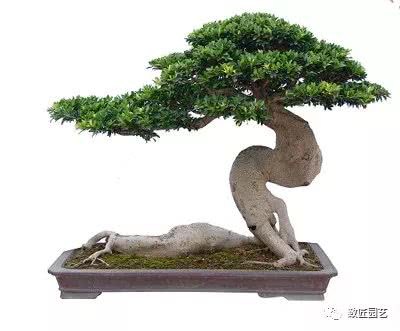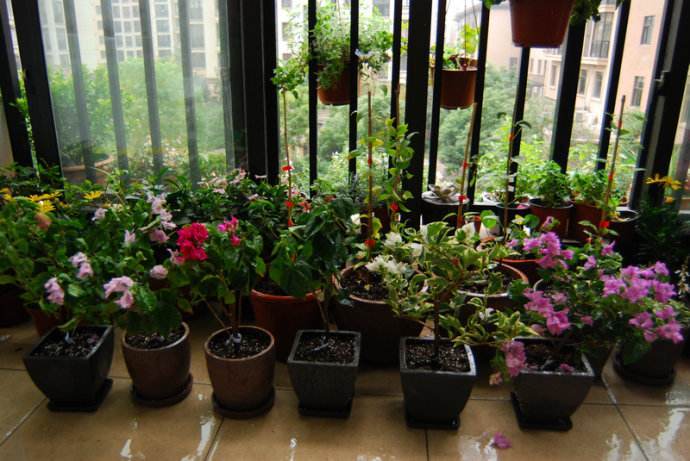Sichuan style bonsai: one chamber full of strength and three peaks out of the crowd

Bonsai, a comprehensive art created by our ancestors to worship nature, combines Chinese philosophy, calligraphy and painting, places the ideal of Chinese people indulging in landscapes, and embodies the purport of Chinese literati. Wang Wei, du Fu, Su Shi, Wang Shipeng and Lu you all wrote poems about bonsai and participated in the production of bonsai, which greatly increased the cultural connotation of bonsai.
Chengdu has a deep relationship with the development of bonsai in China: Liu Chan, the post-Shu master of the three Kingdoms, and Li Xian, the crown prince of Zhang Huai in the Tang Dynasty, all made bonsai in Chengdu, driving the production skills and artistic level of bonsai in Chengdu. The bonsai of Sichuan School, one of the five major schools in China, is deeply rooted in the magnificent and beautiful Bashan Shu River. it is the crystallization of the wisdom of the hardworking Bashu people and an important part of Ba-Shu culture.
Bonsai in China
Bonsai, as its name implies, is an art in which plants and rocks are used as basic materials to express the natural landscape and express the author's thoughts and emotions. it originates from our ancestors' awe and worship of nature and is closely connected with Chinese philosophy, calligraphy and painting. the organic integration of skills and art in the bowl can be said to be a concentrated reflection of human creativity.
The word bonsai appeared relatively late, and the written record we can see today is the poems of Wang Shipeng in the Southern Song Dynasty, but in fact, bonsai appeared very early. Potted plants were found in the Hemudu site in Yuyao, Zhejiang (Neolithic period more than 7000 years ago). Potted flowers were found in the mural of the Eastern Han Dynasty tomb in Wangdu, Hebei Province (more than 1700 years ago). There are six safflower trees planted in a round pot with several frames under the pot, forming the artistic shape of the trinity of plant pots and bowls, which is considered to be the predecessor of modern bonsai.
But what is certain is that the bonsai in the Tang Dynasty has developed to a relatively mature stage. The Imperial Palace Museum has Tang Yan Li's "official tribute map". The exquisitely carved mountains and stones are placed in a shallow basin, which is very similar to the current landscape bonsai. On the east wall of the tomb of Prince Li Xian (son of Wu Zetian) of the Tang Dynasty unearthed in the Qianling Mausoleum of Shaanxi Province, there is a mural of bonsai in hand. The Chronicle Pearl of Feng Zhi, a native of the Tang Dynasty, reads: "Wang Wei used yellow porcelain to store Lanhui, raised a stone, and flourished for many years." Wang Wei (701-761), who resigned in 748, lived in seclusion in Lantian and built a garden, making bonsai with rocks and orchids.
In the Song Dynasty, bonsai art further developed and gradually developed into two main categories: "bonsai tree bonsai" and "landscape bonsai". Bonsai monographs du Fu in the Northern Song Dynasty and Zhao Xihu in the Southern Song Dynasty further enhanced the cultural meaning of bonsai.
Wang Shipeng (1112-1171), a Jinshi and Longtuge bachelor in the Southern Song Dynasty, was an important scholar in the history of bonsai development in China. He built gardens at home, planted flowers and trees, created bonsai, and had rich practice in bonsai production. Nearly 40 poems dedicated to singing praises of flowers and trees, bonsai mountains and rocks have been created: for example, the Story of Rock Pines is the earliest classic document to describe tree-stone bonsai in the history of bonsai in China, which not only has important academic research value. It also has the ideological value of appreciating and appreciating bonsai art works. Wang Shipeng refuted the shallow concept that some people regarded bonsai art as a "plaything" at that time, which greatly promoted the status of bonsai and made bonsai art develop in the direction of poetic elegance and elegance of literati.
In addition, Su Dongpo and Lu you also love bonsai, and some excellent works have been handed down. Su Zi's poem Shuangshi says, "when you dream, you feel good when you are wrong, and you are self-delusional because you are buried in water." But when he saw that the jade peak was too white, he went from the bird path to the absolute Emei. Autumn wind and smoke cloud meaning, dawn Linghan vegetation posture. It's a little clear where it is, and the old man really wants to live in the pool. " It's just crazy. It is recorded in "the beginning of the Book of things": "when plantains start to divide, if the hairpin crosses its root, it does not grow up and can be used as a bonsai." The method of controlling the growth of plantains to make bonsai; another example is Lu you's "rockery to imitate Mr. Wanling's body": "stacked stones for hills and urns for small pools." Next to the negative salary path, in the open fishing nunnery. The sound of the valley should be bells and drums, and the shadow of the waves would invert Songnan. If you ask me, it may be the south of Lushan Mountain. "
In the Yuan Dynasty, bonsai gradually developed to "small", paying attention to the products of bonsai. Mainly to the "cold three friends"-pine, bamboo, plum-based, that this is the high quality of bonsai. The eminent monk, Sui Shangren, traveled everywhere, went in and out of famous mountains and rivers, and accumulated rich. the creation of "some sub-scenes", that is, "small scenes", planted stone trees and flowers, small bridge and flowing water, thatched huts and other common planting pots, although the pot was only full of feet, but swallowed Bohai in anger, and there were holes in the small, which are recorded in detail in Liu Luan's Jade Stone Cottage.
Bonsai was more popular in Ming and Qing dynasties. Bonsai works have more influence on the world. Important bonsai works such as the Pool play Paper in Tu Jiang's Kao Pan Yu Lu in the Ming Dynasty; the pot play in the Chronicle of long things written by Wen Zhenheng in the late Ming Dynasty, one or two volumes about garden design and landscape design; the bonsai by Wang Xiangjin's Qunfang Spectrum; and the method of planting pot scenery in the Flower Mirror by Chen Mingzi in the Qing Dynasty. During the reign of Emperor Kangxi in the Qing Dynasty, the Biography of Mustard seed Garden, compiled by Zhu Sheng, Wang Wei and Wang Gao, was translated and published in Japan in the 13th year of Emperor Qianlong (1784). It was popular in Japan and was regarded as a classic reading by the painting community, affecting the development of Japanese bonsai.
At the end of the Qing Dynasty and the beginning of the Republic of China, bonsai art, which integrates art and skills, has formed its own characteristics in the long-term development practice, among which Sichuan bonsai is an important one.
Sichuan style bonsai is rooted in Bashan Shushui.
Sichuan bonsai is one of the five major schools of traditional Chinese bonsai, which is deeply rooted in the magnificent and beautiful Bashan Shushui. Bonsai production skills represented by Chengdu area are the foundation and core of Sichuan bonsai production skills.
Sichuan style bonsai has a long history, profound cultural heritage, exquisite craftsmanship and strong local characteristics. As early as the period of Shuhan, Lord Liu Zen built an Le Palace in Chengdu, recommended planting trees in the palace, and reproduced the Qifeng dangerous cliff and ancient wood pine in his memory in the pot. Also made of stone, wood bowls of different length and depth, planted with low trees and equipped with rocks, in the palace is "eight" character decoration. Ministers and merchants have followed suit, and this form of landscaping has spread in Chengdu.
Prince Li Xian of Zhang Huai, who was suspected by Wu Zetian in the Tang Dynasty, was demoted to Chengdu and kept company with bonsai plants all day long to make bonsai for pleasure. In the late Tang Dynasty, when Li Deyu served as an envoy to Xichuan, he built a house on the East Lake in Chengdu, where trees and stones were set off with bonsai plants. Du Fu in the Northern Song Dynasty praised the "West Shu Stone" in his Yunlin Stone Spectrum. Wang Shipeng in the Southern Song Dynasty has a poem "Jiannan Bonsai": "Ergong Xin has a clear ancient appearance and is interesting in Linquan. Cunbi lives far from Jinjiang and lives in the west. The hills and valleys in the mountains are like golden valleys with rough stone canals. I have Qianfeng to hide the wild goose, holding up the sky with a pillar of emptiness. " The author's original preface: "Mr. Jinhua has Qi Shibi, who is far away from Shu Chen Hongzhou."... A Yandang Qunfeng wrong cling, all several cases between things. " The author and the two friends who presented themselves with bonsai are experts in bonsai, praising the bonsai made of strange stones from the distant Jinjiang River.
During the Ming and Qing dynasties, the stump banding processing methods and techniques of Sichuan bonsai have been basically finalized, and the annual Qingyang Palace Flower Temple Fair promoted the exchange of bonsai production skills. In the early years of the Republic of China, Panzha's skills were quite mature and complete, and the bonsai skills of tree stumps were raised to a historical height.
Wonderful content
- Prev

Appreciation of bonsai works by Wei Jiquan, a master of bonsai
Mr. Wei Jiquan began to love bonsai art in 1980 and began to appreciate stone collection since 1990. He has invested a lot of money in collecting bonsai and creating bonsai and stone works.
- Next

Stop! you are going to water the flowers to death. The old florist came forward to teach you the right way to bloom and burst the pot.
Stop it! The flowers are going to be watered to death by you. The old florist came forward to teach you the right way. The flowers bloomed and burst. Thank you for watching the editor's article. The editor will, as always, output high-quality content, hoping to bring you happiness at the same time.
Related
- Wuhan Hospital Iron Tree Blooming Result Was Instantly Frightened by the Gardener Master
- Which variety of camellia is the most fragrant and best? Which one do you like best?
- What is the small blue coat, the breeding methods and matters needing attention of the succulent plant
- Dormancy time and maintenance management of succulent plants during dormancy
- Minas succulent how to raise, Minas succulent plant pictures
- What are the varieties of winter succulent plants
- How to raise succulent plants in twelve rolls? let's take a look at some experience of breeding twelve rolls.
- Attention should be paid to water control for succulent plants during dormant period (winter and summer)
- Watering experience of twelve rolls of succulent plants
- Techniques for fertilizing succulent plants. An article will let you know how to fertilize succulent plants.

